For the last few years, Windows 8 has been a part of my daily life. As a part of the Windows 8 engineering team, I spent many hours installing and running Windows 8 on a variety of hardware. I’ve learned a lot about Windows 8 during this time, and I’m looking forward to sharing some of this knowledge and excitement with you. In this post I’ll give an overview of eight of my favorite features and updates in Windows 8.
They are:
- Performance Enhancements
- Navigation and Appearance
- Windows 8 Task Manager
- DirectX 11 Gaming
- Native USB 3.0 Support
- UAS 3.0 and Storage Spaces
- Enhanced Sensor Capabilities
- Enhanced Boot Security and Performance
Performance Enhancements
Windows 8 was engineered to optimize performance and battery life. This enhanced performance is beneficial when using a wide variety of PCs ranging from Windows RT tablets to Windows workstations.
These are a few of the performance investments we made in Windows 8:
- Boot (covered in the last section of this blog post)
- Device Responsiveness (including printing, 3G networks, cameras, USB drives)
- Web browsing
- File copy (bulk file uploads and downloads)
- System efficiency (disk, memory)
Shortly after it was released, I wrote a post on the Samsung Series 9 ultra-thin notebook PC. I really like this PC because it’s thin, it’s light, it has a great screen, and it’s fast! I recently put Windows 8 on this PC and found that it’s even faster compared to my experience with Windows 7. I found that it boots faster, launches Windows Explorer faster (when plugging in a USB drive or my Canon 5D Mark III camera), and also launches playback of video files faster. When it comes to performance, there’s no looking back, Windows 8 delivers!
You can read more about these enhancements on the B8 blog, including posts covering web browsing, power and battery, and memory footprint.
Navigation and Appearance
The first thing you’ll notice when you use Windows 8 is the new Start Screen (with live tiles). Behind the scenes, there are plenty of other less visible new capabilities in the Windows 8 experience that help you perform tasks quickly.
Some of these new power user capabilities include:
- Quick Link Menu – invoked via (Win+X) or right-clicking in lower left screen corner
- Advanced copy file dialog – graph, pause, multiple copy views in a single dialog
- Enhanced keyboard shortcuts (Win+C for Charms, Win+K for devices, and more)
- New Task Manager (See next section)
- Better multi-monitor support (including dual taskbars and image spanning)
There’s plenty more, but this “starter list” gives you an idea of some of the great features and improvements that were added for Windows 8.
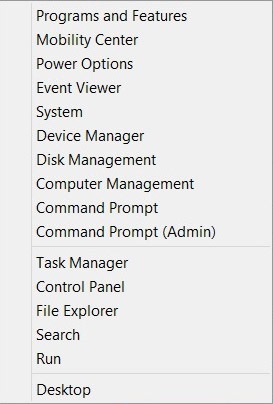
The Quick Link menu – lots of great one-click features!
If you run more than one display, you’ll want to check out desktop background spanning in Windows 8. The first thing you’ll need is an image of sufficient width. For a side by side dual monitor setup, just add up the horizontal resolution for each display, in my case this was 2560 + 2560 = ~5120 pixels wide. To demonstrate this feature I took a screen grab from some 5K video footage that I shot this fall with a RED Epic camera, and set it as my desktop wallpaper. By default, you’ll see the same image on each display. However, once you select the “span” setting in the Desktop Background Control Panel, you’ll see a panoramic image spanning across your displays. Here’s a screen capture comparison showing the resultant screen real estate with the “fit” option (mirrored) and the “span” option (continuous):

Wallpaper image fit to each display

Wallpaper image spanning both displays
And here’s what I see when sitting at the workstation, very cool! It’s as if your displays are windows and your image is behind them.
Now I’m going to have to go out and shoot some really nice panoramic landscape shots to use as wallpaper!
There are additional multi-monitor enhancements in Windows 8:
- The ability to show different images on each display
- Background image slide show
- Multi-monitor taskbar (as shown above)
If you want to read more about multi-monitor enhancements in Windows 8, check out this blog post. I’ll also be blogging more about mouse navigation, keyboard navigation and other related stories in future posts.
Windows 8 Task Manager
Windows 8 has a better Task Manager and it’s my go-to place to check up on system resources, monitor apps, terminate processes, and countless other tasks. Here is what it looks like:
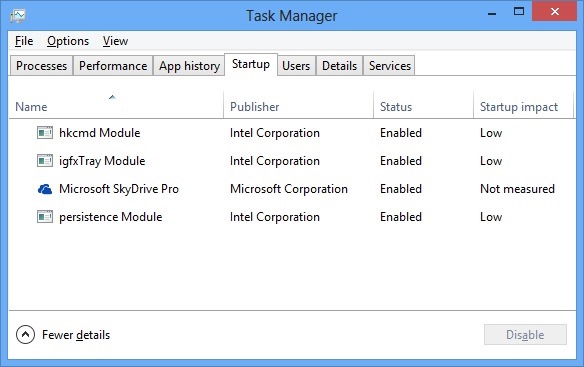
The startup tab in the new Task Manager for Windows 8
Did you know that you can easily control startup process options by right-clicking on items in the Startup tab in the new Task Manager? It’s that easy! If you’ve used msconfig to optimize startup behavior in the past, you’ll want to check out this new “Startup” tab in the Windows 8 Task Manager.
Have you ever spent too much time searching through the task manager to find the process or service that you’re looking for? The Windows 8 Task Manager makes this much easier because it groups processes into sections for apps, background processes, and Windows processes. For services, the task manager shows the “friendly name” for each service running so that you can easily examine what’s going on.
There a ton more information about the Windows 8 Task Manager here.
DirectX 11 Gaming
If you haven’t seen the latest wave of innovation in DirectX PC games, they are amazing! These games feature super-realistic immersive environments, interactive physics modeling, amazing human characters, and high resolution textures. These games are more exciting and more realistic than ever before, and just when you thought it couldn’t get any better the next amazing game is released. I can’t believe I get paid to do this.
Here are some of the many recent DirectX 11 game titles:
In order to bring to life these experiences to life, Windows 8 supports the latest GPU hardware including the AMD Radeon 7970, NVIDIA GeForce GTX 690, and many others.
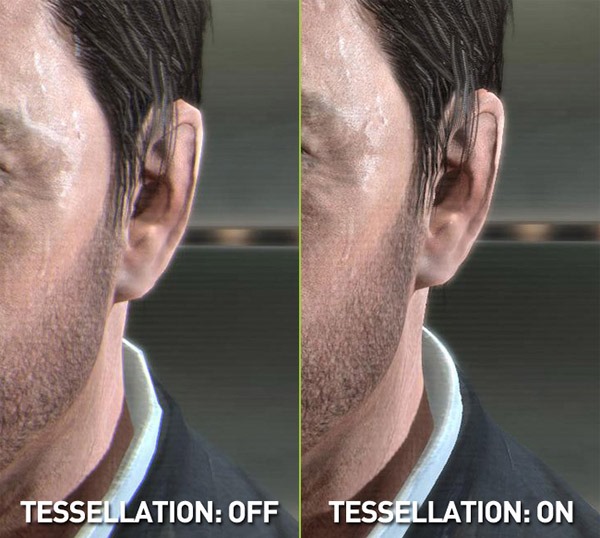
Tessellation with DirectX 11 – Note the top of the ear and the collar area where enhanced edges and curves are observed – Image courtesy NVIDIA
For more information about DirectX 11 exclusive features and optimizations in games, check out this article from NVIDIA. We will be covering DirectX 11 and PC gaming in more detail in future posts.
Native USB 3.0 Support
Windows 8 natively supports USB 3.0. USB 3.0 is up to 10x faster than USB 2.0, so it’s great when transferring large quantities of data to and from an external device. Windows 8 native support for USB 3.0 ensures more consistent USB 3.0 feature support, better device compatibility, and improved power management that results in longer battery life. In addition, there are already hundreds of millions of USB 1.0 and 2.0 devices that also work great with Windows 8.
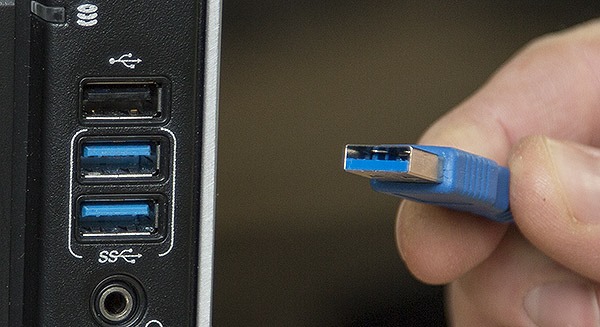
Blue means fast! – USB 3.0 (Superspeed) ports and device cable
I’ll be talking more about Windows 8 USB 3.0 support and devices in future posts, but in the mean time you can read more about USB in Windows 8 here.
UAS 3.0 and Storage Spaces
Large scale storage has become an ever increasing need for today’s power user. Fortunately Windows 8 has some great new storage features that help out here! To start, Windows 8 offers native support for UAS 3.0, which translates to increased drive performance, better drive interoperability, and power savings as well. Windows 8 also introduces a new feature called Storage Spaces.
Storage Spaces offers:
- Support for inexpensive USB HDDs
- Easy expansion
- Mirrored resiliency
- Easy management via Control Panel or PowerShell
- RAID-like performance
Storage Spaces in Windows 8 is also very easy to setup. There’s two easy ways to get to Storage Spaces management:
- At the Start Screen, type “Storage Spaces” then click on “Settings” in the right pane, select “Manage Storage Spaces” from the results
- Launch the Control Panel, then navigate to System and SecurityStorage Spaces, then click on “Manage Storage Spaces”
In Storage Spaces management, you can create a Storage Space with only a few clicks.

Storage Spaces landing page in the Control Panel
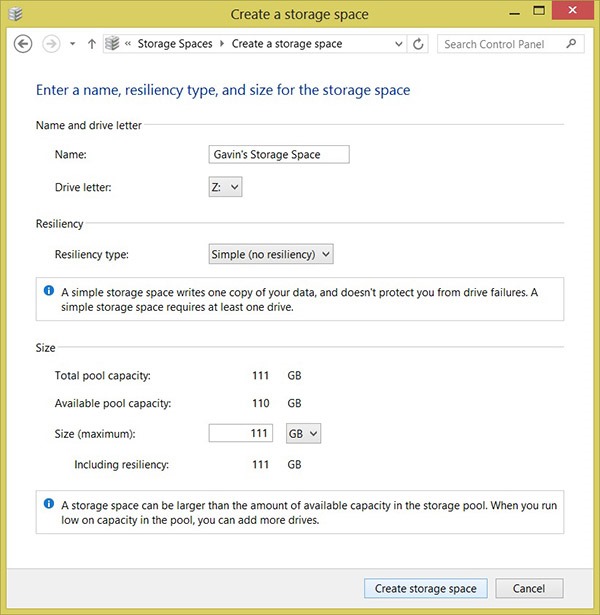
Creating a new Storage Space – Options

Storage Spaces show up like any other drive in Windows Explorer
Enhanced Sensor Capabilities
For Windows 8, sensors play an important role in delivering interactive experiences. In order to create an optimal tablet experience, light sensors and accelerometer sensors are used to automatically control screen brightness and auto-rotate the display. Furthermore, all tablet PCs have a full 9-axis sensor fusion sensor hardware capability (3D accelerometer, 3D gyro, 3D magnetometer). These sensors together implement support for “Sensor Fusion” – an exciting new capability for Windows 8 that enables smooth and accurate compass readings, as well as powerful 3D motion detection that’s perfect for interactive gaming experiences and other kinds of interactive applications. Windows 8 includes class driver support for sensors (via new standards additions to HID), and an extensive set of APIs for developers that are writing Windows Store apps. For more information about Sensor support in Windows 8, check out my blog post here.
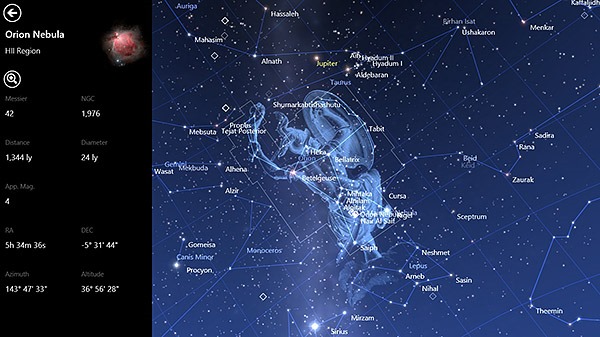
Star Chart, an app that uses sensor fusion – available on the Windows Store
Enhanced Boot Security and Performance
In order to ensure that Windows 8 security is optimized, countless aspects of PC hardware and software security were considered during the development of Windows 8. One of these considerations was to incorporate UEFI (Unified Extensible Firmware Interface) secure boot into the Windows boot architecture. With UEFI secure boot, the risk of loading a compromised Windows image is greatly reduced which translates to less susceptibility to certain types of security attacks. It’s just one of the many ways that Windows 8 integrates with UEFI system firmware.
In addition, boot performance has also been significantly boosted in Windows 8. We developed Windows 8 fast start up which intelligently shuts down and boots your PC. With Windows 8, you’ll be surprised how quickly your PC hibernates, resumes, and boots. If you want to know more, there is a blog post with detail on Windows 8 fast start up here.
These are a few of my favorite Windows 8 features and I’ve really only scratched the surface here! In future posts, I’ll cover more on these topics and take a close look at new Windows 8 PCs, peripherals/components/accessories for Windows 8, and of course apps running on Windows 8. I look forward to sharing this with all of you. If you want to stay up to date, Follow me on Twitter!

